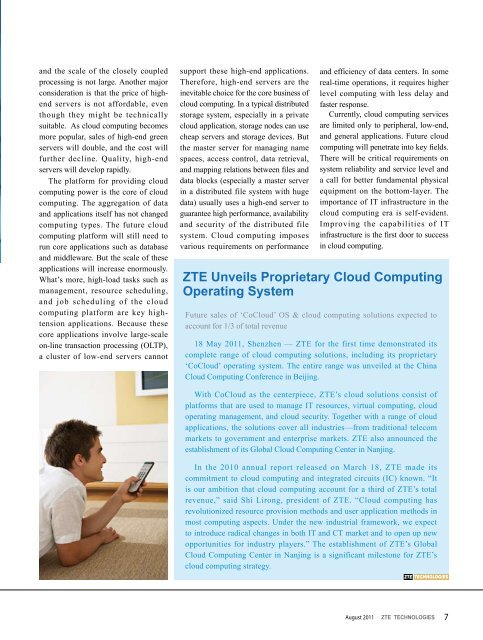You also want an ePaper? Increase the reach of your titles
YUMPU automatically turns print PDFs into web optimized ePapers that Google loves.
and the scale of the closely coupledprocessing is not large. Another majorconsideration is that the price of highendservers is not affordable, eventhough they might be technicallysuitable. As cloud computing becomesmore popular, sales of high-end greenservers will double, and the cost willfurther decline. Quality, high-endservers will develop rapidly.The platform for providing cloudcomputing power is the core of cloudcomputing. The aggregation of dataand applications itself has not changedcomputing types. The future cloudcomputing platform will still need torun core applications such as databaseand middleware. But the scale of theseapplications will increase enormously.What’s more, high-load tasks such asmanagement, resource scheduling,and job scheduling of the cloudcomputing platform are key hightensionapplications. Because thesecore applications involve large-scaleon-line transaction processing (OLTP),a cluster of low-end servers cannotsupport these high-end applications.Therefore, high-end servers are theinevitable choice for the core business ofcloud computing. In a typical distributedstorage system, especially in a privatecloud application, storage nodes can usecheap servers and storage devices. Butthe master server for managing namespaces, access control, data retrieval,and mapping relations between files anddata blocks (especially a master serverin a distributed file system with hugedata) usually uses a high-end server toguarantee high performance, availabilityand security of the distributed filesystem. Cloud computing imposesvarious requirements on performanceand efficiency of data centers. In somereal-time operations, it requires higherlevel computing with less delay andfaster response.Currently, cloud computing servicesare limited only to peripheral, low-end,and general applications. Future cloudcomputing will penetrate into key fields.There will be critical requirements onsystem reliability and service level anda call for better fundamental physicalequipment on the bottom-layer. Theimportance of IT infrastructure in thecloud computing era is self-evident.Improving the capabilities of ITinfrastructure is the first door to successin cloud computing.<strong>ZTE</strong> Unveils Proprietary Cloud ComputingOperating SystemFuture sales of ‘CoCloud’ OS & cloud computing solutions expected toaccount for 1/3 of total revenue18 May 2011, Shenzhen — <strong>ZTE</strong> for the first time demonstrated itscomplete range of cloud computing solutions, including its proprietary‘CoCloud’ operating system. The entire range was unveiled at the ChinaCloud Computing Conference in Beijing.With CoCloud as the centerpiece, <strong>ZTE</strong>’s cloud solutions consist ofplatforms that are used to manage IT resources, virtual computing, cloudoperating management, and cloud security. Together with a range of cloudapplications, the solutions cover all industries—from traditional telecommarkets to government and enterprise markets. <strong>ZTE</strong> also announced theestablishment of its Global Cloud Computing Center in Nanjing.In the 2010 annual report released on March 18, <strong>ZTE</strong> made itscommitment to cloud computing and integrated circuits (IC) known. “Itis our ambition that cloud computing account for a third of <strong>ZTE</strong>’s totalrevenue,” said Shi Lirong, president of <strong>ZTE</strong>. “Cloud computing hasrevolutionized resource provision methods and user application methods inmost computing aspects. Under the new industrial framework, we expectto introduce radical changes in both IT and CT market and to open up newopportunities for industry players.” The establishment of <strong>ZTE</strong>’s GlobalCloud Computing Center in Nanjing is a significant milestone for <strong>ZTE</strong>’scloud computing strategy.August 2011<strong>ZTE</strong> TECHNOLOGIES7
















